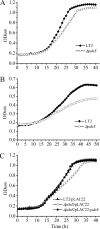Characterization of the PduS cobalamin reductase of Salmonella enterica and its role in the Pdu microcompartment
- PMID: 20656910
- PMCID: PMC2944522
- DOI: 10.1128/JB.00575-10
Characterization of the PduS cobalamin reductase of Salmonella enterica and its role in the Pdu microcompartment
Abstract
Salmonella enterica degrades 1,2-propanediol (1,2-PD) in a coenzyme B12 (adenosylcobalamin, AdoCbl)-dependent fashion. Salmonella obtains AdoCbl by assimilation of complex precursors, such as vitamin B12 and hydroxocobalamin. Assimilation of these compounds requires reduction of their central cobalt atom from Co3+ to Co2+ to Co+, followed by adenosylation to AdoCbl. In this work, the His6-tagged PduS cobalamin reductase from S. enterica was produced at high levels in Escherichia coli, purified, and characterized. The anaerobically purified enzyme reduced cob(III)alamin to cob(II)alamin at a rate of 42.3±3.2 μmol min(-1) mg(-1), and it reduced cob(II)alamin to cob(I)alamin at a rate of 54.5±4.2 nmol min(-1) mg(-1) protein. The apparent Km values of PduS-His6 were 10.1±0.7 μM for NADH and 67.5±8.2 μM for hydroxocobalamin in cob(III)alamin reduction. The apparent Km values for cob(II)alamin reduction were 27.5±2.4 μM with NADH as the substrate and 72.4±9.5 μM with cob(II)alamin as the substrate. High-performance liquid chromatography (HPLC) and mass spectrometry (MS) indicated that each monomer of PduS contained one molecule of noncovalently bound flavin mononucleotide (FMN). Genetic studies showed that a pduS deletion decreased the growth rate of Salmonella on 1,2-PD, supporting a role in cobalamin reduction in vivo. Further studies demonstrated that the PduS protein is a component of the Pdu microcompartments (MCPs) used for 1,2-PD degradation and that it interacts with the PduO adenosyltransferase, which catalyzes the terminal step of AdoCbl synthesis. These studies further characterize PduS, an unusual MCP-associated cobalamin reductase, and, in conjunction with prior results, indicate that the Pdu MCP encapsulates a complete cobalamin assimilation system.
Figures





Similar articles
-
Biochemical evidence that the pduS gene encodes a bifunctional cobalamin reductase.Microbiology (Reading). 2005 Apr;151(Pt 4):1169-1177. doi: 10.1099/mic.0.27755-0. Microbiology (Reading). 2005. PMID: 15817784
-
Reduction of Cob(III)alamin to Cob(II)alamin in Salmonella enterica serovar typhimurium LT2.J Bacteriol. 2000 Aug;182(15):4304-9. doi: 10.1128/JB.182.15.4304-4309.2000. J Bacteriol. 2000. PMID: 10894741 Free PMC article.
-
Characterisation of PduS, the pdu metabolosome corrin reductase, and evidence of substructural organisation within the bacterial microcompartment.PLoS One. 2010 Nov 16;5(11):e14009. doi: 10.1371/journal.pone.0014009. PLoS One. 2010. PMID: 21103360 Free PMC article.
-
Multiple roles of ATP:cob(I)alamin adenosyltransferases in the conversion of B12 to coenzyme B12.Appl Microbiol Biotechnol. 2010 Sep;88(1):41-8. doi: 10.1007/s00253-010-2773-2. Epub 2010 Jul 31. Appl Microbiol Biotechnol. 2010. PMID: 20677021 Free PMC article. Review.
-
Prokaryotic Organelles: Bacterial Microcompartments in E. coli and Salmonella.EcoSal Plus. 2020 Oct;9(1):10.1128/ecosalplus.ESP-0025-2019. doi: 10.1128/ecosalplus.ESP-0025-2019. EcoSal Plus. 2020. PMID: 33030141 Free PMC article. Review.
Cited by
-
Glycyl Radical Enzyme-Associated Microcompartments: Redox-Replete Bacterial Organelles.mBio. 2019 Jan 8;10(1):e02327-18. doi: 10.1128/mBio.02327-18. mBio. 2019. PMID: 30622187 Free PMC article. Review.
-
Electrochemical cofactor recycling of bacterial microcompartments.Proc Natl Acad Sci U S A. 2024 Dec 3;121(49):e2414220121. doi: 10.1073/pnas.2414220121. Epub 2024 Nov 25. Proc Natl Acad Sci U S A. 2024. PMID: 39585991 Free PMC article.
-
Chemical probing provides insight into the native assembly state of a bacterial microcompartment.Structure. 2022 Apr 7;30(4):537-550.e5. doi: 10.1016/j.str.2022.02.002. Epub 2022 Feb 24. Structure. 2022. PMID: 35216657 Free PMC article.
-
Structure and expression of propanediol utilization microcompartments in Acetonema longum.J Bacteriol. 2014 May;196(9):1651-8. doi: 10.1128/JB.00049-14. Epub 2014 Feb 14. J Bacteriol. 2014. PMID: 24532773 Free PMC article.
-
A taxonomy of bacterial microcompartment loci constructed by a novel scoring method.PLoS Comput Biol. 2014 Oct 23;10(10):e1003898. doi: 10.1371/journal.pcbi.1003898. eCollection 2014 Oct. PLoS Comput Biol. 2014. PMID: 25340524 Free PMC article.
References
-
- Banerjee, R. 2006. B12 trafficking in mammals: a case for coenzyme escort service. ACS Chem. Biol. 1:149-159. - PubMed
-
- Banerjee, R. (ed.). 1999. Chemistry and Biochemistry of B12. John Wiley and Sons, New York, NY.
Publication types
MeSH terms
Substances
LinkOut - more resources
Full Text Sources
Molecular Biology Databases
Miscellaneous

